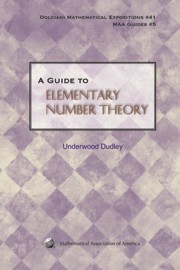
-
The digital format of this book is no longer available to purchase from Cambridge Core. Other formats may be available.
-
Select format
-
- Publisher:
- Mathematical Association of America
- Publication date:
- Invalid date
- August 2009
- ISBN:
- 9780883853474
- Dimensions:
- Weight & Pages:
- 00kg,
- Dimensions:
- Weight & Pages:
- Subjects:
- Mathematics, Number Theory
You may already have access via personal or institutional login- Subjects:
- Mathematics, Number Theory
Book description
CHOICE Award winner! A Guide to Elementary Number Theory is a 140-page exposition of the topics considered in a first course in number theory. It is intended for those who may have seen the material before but have half-forgotten it, and also for those who may have misspent their youth by not having a course in number theory and who want to see what it is about without having to wade through a traditional text, some of which approach 500 pages in length. It will be especially useful to graduate student preparing for the qualifying exams. Underwood Dudley received the Ph.D. degree (number theory) from the University of Michigan in 1965. He taught at the Ohio State University and at DePauw University, from which he retired in 2004. He is the author of three books on mathematical oddities, The Trisectors, Mathematical Cranks, and Numerology all published by the Mathematical Association of America. He has also served as editor of the College Mathematics Journal, the Pi Mu Epsilon Journal, and two of the Mathematical Association of America's book series.
Reviews
Anyone who wishes to learn what elementary number theory is about and some of its important, yet open, questions will not find a better resource.The author provides the basic pertinent definitions and theorems in elementary number theory, ranging from greatest common divisors to quadratic recipocity to Waring's problems. A valuable resource for any student especially graduate students preparing for qualifying exams.
J. T. Zerger Source: CHOICE
Contents
Metrics
Altmetric attention score
Full text views
Full text views help Loading metrics...
Loading metrics...
* Views captured on Cambridge Core between #date#. This data will be updated every 24 hours.
Usage data cannot currently be displayed.
Accessibility standard: Unknown
Why this information is here
This section outlines the accessibility features of this content - including support for screen readers, full keyboard navigation and high-contrast display options. This may not be relevant for you.
Accessibility Information
Accessibility compliance for the PDF of this book is currently unknown and may be updated in the future.


